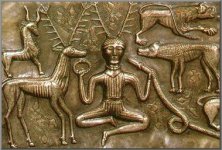Hi Roseanne,
Rosanne said:
Hi Ross I know nothing of the Witches Sabbat, so I will be interested in looking. My image of Lilitu, is the same as prudence and comes from a mythology book. Ereshkigal did not have sacred Owls as her Familiars- nor did she have wings. The hat is made of Lunar Horns. ~Rosanne
I think most scholars don't accept that this plaque is a representation of the demoness Lilitu. There is so much that is unclear about Mesopotamian mythology, and this sculpture's identity is far from certain.
For a good discussion, see -
http://www.history.upenn.edu/~humm/Topics/Lilith/
(and follow the first few links for more details)
A very similar image, from Babylonian (not Sumerian) times, shows no owls, and she stands on a pair of ibexes.
It is a very old sculpture and there is no inscription. It is hard to associate her to any specific mythological background, I think. The multiple crowns always indicated high divinity in Mesopotamian iconography. The lions would belong to Inanna. Her clawed feet indicate a bird of prey, and the owls are nocturnal. Isaiah 34:14 uses "lilith", usually translated "screech-owl", and this is the basis for this association with the owls in this sculpture.
But the sculpture is at least a thousand years older than Isaiah, and (as you have read at the link above) Samuel Noah Kramer's translation of "lilith" in part of the Gilgamesh story is very questionable (the name is "kiskililu" or "lilake" (most likely the former)), mostly because of the associations it brings up with Jewish folklore, first wife of Adam, etc.
All we know about lilitu in Mesopotamian mythology is that she was a demon of the wilderness who stole babies at birth. Then Assyriology-studen Renee Rosen wrote a good letter about her on the Ancient Near East discussion list way back in 1997 -
http://oi.uchicago.edu/OI/ANE/ANE-DIGEST/1997/v1997.n145
(scroll about half-way down)
But there is no doubt for me that our figure is a goddess, and not a demon. In addition to the horns, she holds the "line and measure" symbols of rule (as "rule" literally means - to lay down the law, circumscribe the perimeter).



